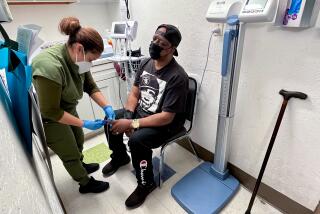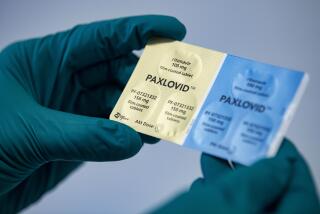Cardiologists cast doubt on new statin recommendations
Some of the nation’s most influential cardiologists are challenging new recommendations that would greatly expand the number of Americans taking a statin medication to reduce their chances of a heart attack or stroke.
The guidelines issued last week by the American Heart Assn. and the American College of Cardiology were accompanied by a “risk calculator” that was supposed to identify patients whose odds of suffering either a stroke or a heart attack over the next 10 years were judged to be at least 7.5%. These patients could reduce their risk by taking a low-dose statin, the medical groups said. The calculator’s individualized estimates were based on age, gender, total cholesterol, blood pressure and smoking history, among other variables.
But a Harvard University cardiologist and his biostatistician collaborator have taken the freshly minted recommendations to task, arguing that they were formulated with unreliable data on Americans’ health and that the calculations about which patients should take a statin are wildly off base.
Dr. Paul Ridker and Dr. Nancy Cook, both professors at Harvard, estimate that between 13 million and 16 million of the 33 million middle-aged adults targeted for statin therapy under the new guidelines do not have sufficiently high odds of a heart attack or stroke to warrant a prescription for a statin. Meanwhile, they warned, the risk calculator might give an all-clear signal to other patients for whom statin therapy would be helpful.
Ridker and Cook used the new risk calculator to estimate the 10-year odds of a heart attack or stroke in thousands of people who participated in three landmark medical studies: the Women’s Health Initiative, the Women’s Health Study and the Physicians’ Health Study. When the pair plugged in the real data from study volunteers, the calculator produced estimates that “were almost twice as high as they actually were,” said Cook, a biostatistician at Brigham and Women’s Hospital and a professor of epidemiology at the Harvard School of Public Health.
In an interview Monday, Cook said the scientific advisors who helped develop the guidelines acknowledged in the report’s fine print that the risk assessments were sometimes quite different when tested on groups of people that weren’t used to develop the calculator.
“They knew this,” Cook said. “I think they should have done something about it, tried to figure out what was going on here.”
The full critique from Cook and Ridker, a cardiologist at Brigham and Women’s Hospital who has been an advocate for expanded statin use, will be published Tuesday in the British journal Lancet.
Dr. Steven Nissen, an influential cardiologist at the Cleveland Clinic, said the analysis from Cook and Ridker should prompt the American Heart Assn. and the American College of Cardiology to “take a deep breath and take another look at this” before putting the guidelines into widespread practice.
“If you put the data from hypothetical patients into the calculator, you can get results that are very implausible,” Nissen said. “It’s concerning: we’re not talking about an error or miss of 20 or 30%, but of 75% to 150%.”
The chief author of the guidelines, Dr. Neil Stone, offered a stout defense of the calculator, which he said was intended to be just the first step in a process of consultation in which both patient preference and a doctor’s clinical judgment are to be considered.
“We erred on the conservative side of caution” in identifying patients who should have that conversation, said Stone, a cardiologist and professor at Northwestern University’s Feinberg School of Medicine.
But, he added, the bases for the risk calculator “were reviewed on several occasions by multiple reviewers. They were internally and externally validated, and all the populations they checked it against were microcosms of the U.S. population.”
By contrast, the study subjects that Ridker and Cook used for comparison were “low-risk populations,” Stone said. Many of them were health professionals who were less likely to suffer a heart attack or stroke than today’s typical American adult, he said. In addition, groups whose risks tend to be particularly high — such as African Americans and older patients — were not well represented in the studies Ridker and Cook used, he added.
The brewing debate has also raised questions about a guideline-writing process that has steadily increased the number of Americans taking statins, and the motives of drug manufacturers who play a major role in funding research.
In 2001, practice guidelines boosted the number of Americans who should be on cholesterol-lowering medications from 13 million to 36 million. By most estimates, the latest guidelines would roughly double that figure. Most of the once-costly statins — with the exception of Crestor — are now available in an inexpensive generic form, though new drugs to lower cholesterol and reduce heart attack and stroke risk are under development.
Among the 11 authors of the latest guidelines, only one had financial ties — in the form of consulting or speaking fees or an ownership stake — to a drug company whose work was relevant to the deliberations. But the American College of Cardiology continues to have close ties to the pharmaceutical industry.
“There is overtreatment that’s been built into the risk calculator, and this is a warning sign about the overtreatment that’s built into the guidelines themselves,” said Dr. John Abramson, a Harvard University cardiologist who has argued that statins offer little value to people with a 10-year risk of heart attack or stroke below 20%.
“There aren’t brakes being put on the enthusiasm and overreaching of the experts,” he said. “There are statin believers, and when you hear these experts talk, they’re talking emotionally, not scientifically.”







